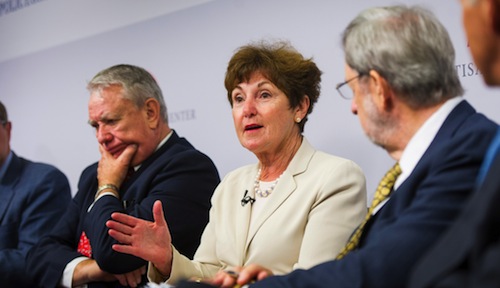
Private-sector executives want to invest more in U.S. infrastructure projects but say regulatory and other barriers are hampering their efforts. Some agencies are addressing the problem.
Jack Ehnes, California State Teachers’ Retirement System CEO, told reporters in an Aug. 10 Bipartisan Policy Center conference call, “Clearly institutional investors have capital available. But we [in the U.S.] absolutely have a very uneven regulatory-political environment that has not made the country nearly as attractive as other parts of the world.”
A 2014 Obama administration infrastructure investment “summit” led to recommendations this year for ways to lower barriers. McGraw Hill Financial CEO Douglas Peterson says, “I think it was a very valuable initiative. There has been progress.” He cites the Agriculture Dept., which is seeking more private help for its infrastructure loan programs.
Dept. of Transportation spokesperson Jon Romano says DOT’s year-old “one-stop shop” for public agencies and investors “has made significant progress” in broadening access to its credit programs and providing them with new tools and technical help.
Still, DOT’s Transportation Infrastructure Finance and Innovation Act (TIFIA) program, whose loans have helped major projects, has hit recent bumps. DOT closed nearly $7.5 billion in TIFIA loans in fiscal 2014, but this year failed to hit a legislatively mandated loan target. On April 24 DOT took $639.9 million in uncommitted 2015 TIFIA funds and gave them to states as regular highway aid. Each federal TIFIA dollar supports about $10 in loan volume.
Jane Garvey, North America chairman for investment firm Meridiam, notes that TIFIA projects can be complicated and take time to examine. David Bauer, American Road & Transportation Builders Association senior vice president, says all agree DOT should scrutinize loan applications, but adds, “We continually hear that there is a logjam over there.”
But DOT's Romano also points out that because a long-term transportation bill hasn't been enacted, “Sponsors are hesitant to advance large-scale infrastructure projects that would require multi-year commitments. This is particularly true for projects interested in TIFIA due to their long time frames and the [financing] benefits TIFIA provides….”
During the Senate debate on the highway-transit bill it passed on July 30, the sponsors trimmed TIFIA twice, to $300 million. Its 2015 level is $1 billion. Bauer says the cut wasn’t “necessarily a statement of hostility towards the TIFIA program [but] more a reality that senators were saying, ‘We don’t have enough money to do what we want to do in any area….”
Garvey, a former top federal aviation and highway administration official, calls the cuts “a concern,” but says $300 million is “still a good number.”


Post a comment to this article
Report Abusive Comment